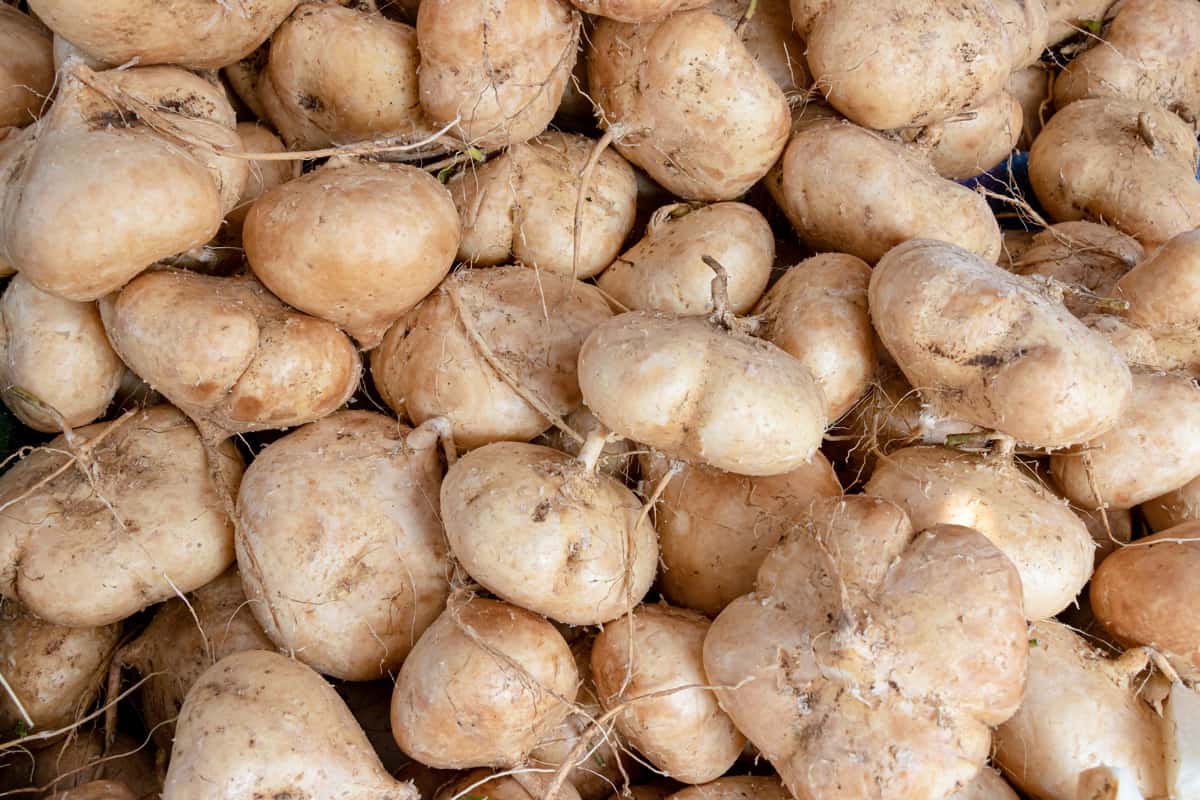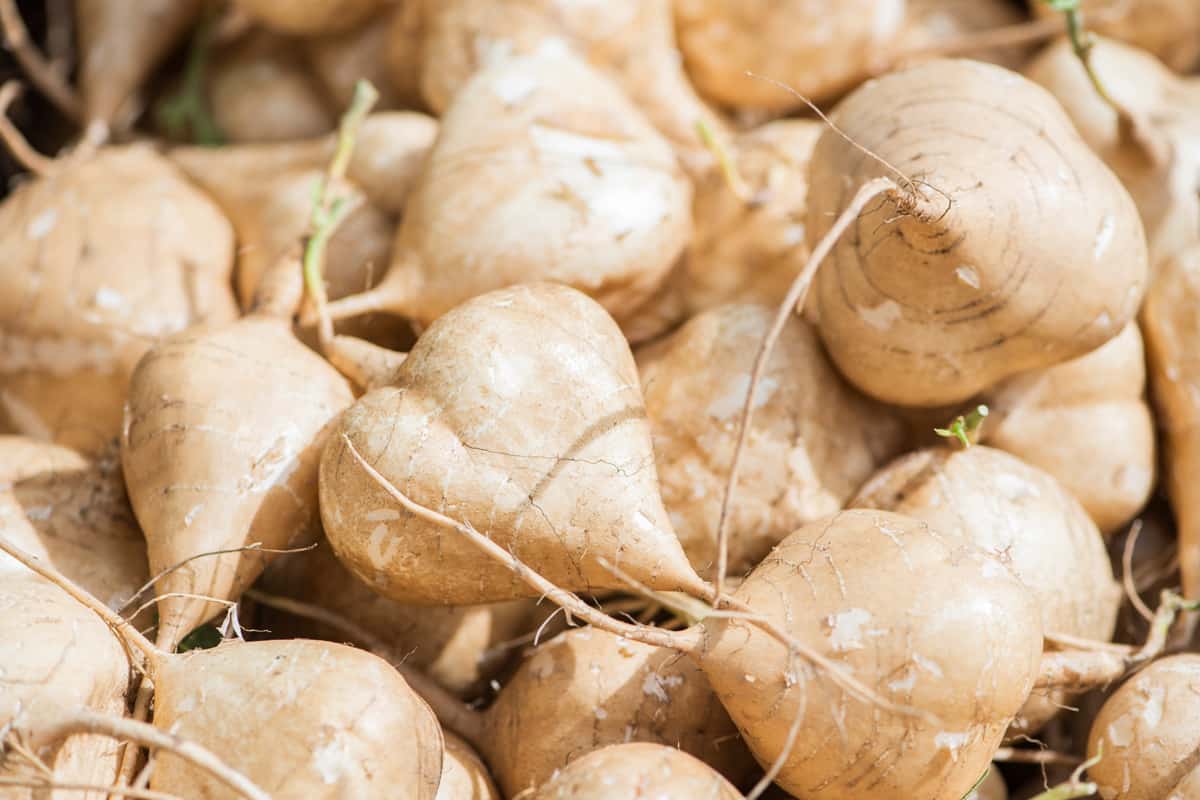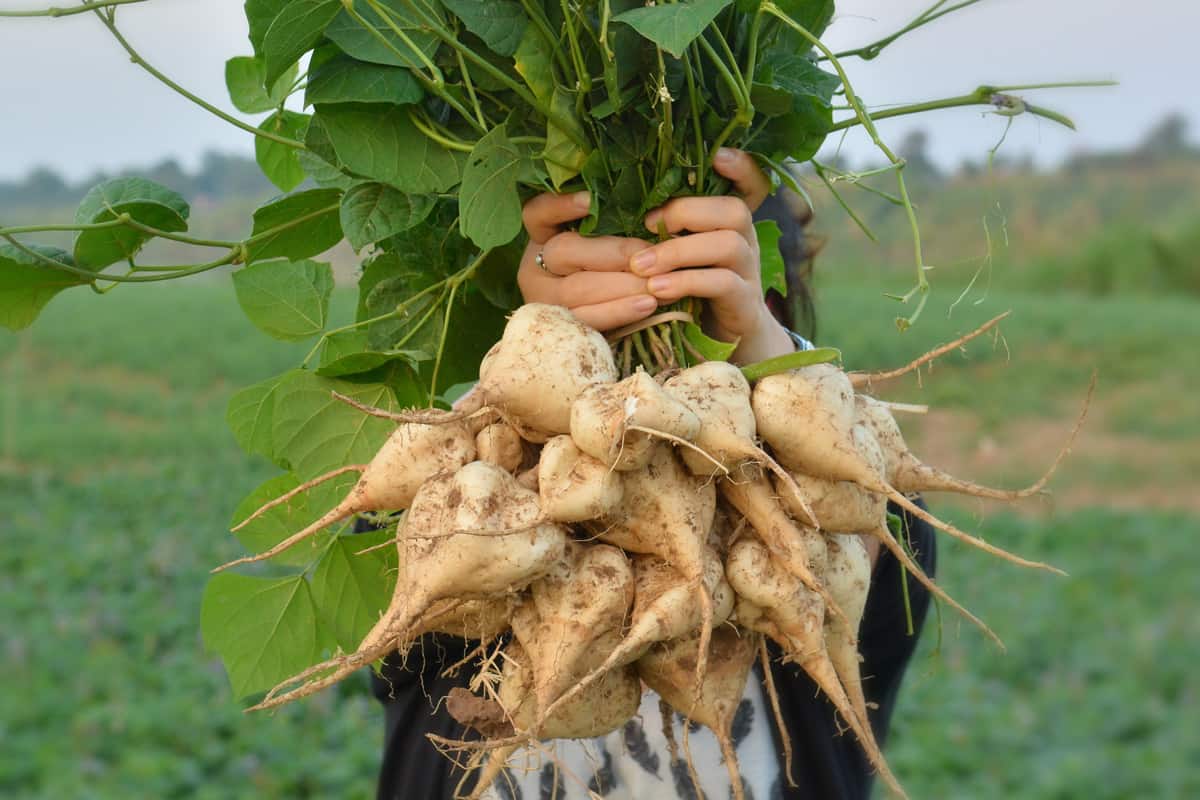Finding new ways to expand your garden isn't always easy. You may want to grow jicamas using a tuber but don't know whether it's possible. What is the best way to produce a new plant with this species? Luckily, we've done plenty of research and have the answers below!
You can't usually use a jicama tuber to grow another plant. Generally, this root vegetable is best grown by using seeds, not tubers.
In this article, we will cover everything related to growing jicamas and discuss the best way to do this. Whether you're new to this root vegetable, have a few in your garden, or need other help, we've got your back. With that said, let's dive right into this topic!
Does A Jicama Have Tubers?

Yes, a jicama has a tuber. Typically, your jicama plant produces tubers to store extra food and energy for the host plant.
The tuber can't usually be propagated and turned into another full-blown vegetable. Most garden experts recommend against using the tuber for propagation, as this can take away essential nutrients your existing vegetable needs. The most reliable way to grow jicama in your yard is with seeds.
A common misconception about jicamas is that their tubers work similarly to potatoes. That isn't true, as potato tubers are plentiful and respond well to propagation.
Will A Jicama Tuber Grow Into A New Plant?
Since this root vegetable doesn't usually respond well to propagation, it's not reliable to depend on your jicama's tuber to create a new plant. Some people have tried this and had success, but usually, the jicama tuber won't grow into a different plant.
Instead, you want to grow additional jicamas using seeds. When you do this, you can expect most jicama seeds to germinate within 20 days, which is still a bit of a waiting period.
Jicamas can be tricky to grow if you don't know what you're doing, so a tip for faster germination is to soak the seeds in warm water before planting them.
Even though the jicama plant grows a tuber like potatoes, you can't rely on them to be as easy to replant and grow. According to professionals, you can't cut up a jicama and cultivate it as you would a potato.
Of course, that's not to say that removing the tuber from your jicama and trying to grow it won't ever be successful, but it's far riskier than simply buying seeds and going that route.
What Type Of Plant Is A Jicama?

Jicama is a root vegetable native to Mexico and Central America. You may also know this plant as the jícama Mexican turnip, which gets its name from the plant's edible tuberous root.
One of the reasons so many gardeners think the tubers may be propagation-friendly is because they are a popular snack.
On top of that, jicama belongs to the Pachyrhizus erosus in the pea family, so it's closely related to various vegetables we all know and love.
The jicama usually has a fleshy brown color. It is used for cooking (especially soups). The jicama has been described as a mix of white potato and a Chinese water chestnut, having a blander taste.
A jicama may grow to weigh over five pounds, so this root vegetable can become large in ideal growing conditions. Generally, the warmer and wetter you keep a jicama plant, the larger it will grow.
Again, jicama is excellent for planting and cooking and can be a good option for people who prefer to produce garden-to-table crops.
Where Is The Best Place To Grow Jicama?

This root vegetable species loves having somewhere to climb, so it's a good idea to plant your jicama near a trellis.
Many experts suggest growing jicamas in the full sun alongside a sturdy trellis, where they will thrive and mature. You should space your jicamas 12 inches from each other. This will ensure their roots don't compete for nutrients, water, and room underground: which is essential for your plants.
Jicamas need warm soil that is well-drained and full of nutrients. So, add natural matter to the ground to improve its quality.
This could be several inches of aged compost or other rich organic matter. Giving your jicamas plenty of natural ingredients will speed up their growth, making for faster-growing vegetables.
Jicamas should be easy to grow as long as you keep their soil and nutrients in good shape.
Check out this trellis on Amazon.
How Long Does It Take To Grow Jicama By Seed?

Since jicamas grow moderately slowly once germination happens, you can expect your vegetables to be ready for harvest roughly 150 days post-planting.
Usually, jicama tubers will be ready to harvest within four months for smaller plants and closer to nine months for larger jicamas. Again, this root vegetable is a slow grower, so don't worry if your seeds take 20+ days to start peeking out from the soil.
As we recommended earlier, you can soak your jicama seeds in warm water before you plant them. Doing this can make your seeds germinate faster in the soil.
In addition, planting jicamas in ideal garden areas with bright sun can also help with seed growing. If you plant jicama seeds in shadier spots, expect a longer germination and growing period.
You also want to wait until the last frost of the year has happened before planting jicamas. Since this vegetable species is native to Mexico, it doesn't respond well to the cold. Jicamas grow best in warmer USDA growing zones (10-12).
With that said, you may be able to grow and harvest jicama in cooler USDA regions, but don't expect them to do as well as they would in a warmer area. The more sun and less frost, the better.
How To Make Jicama Grow Faster

If your jicama is taking ages to grow, there are some ways to speed up the process. Generally, this plant grows fastest in tropical or sub-tropical conditions.
Therefore, give your jicama full sun, nutrient-rich soil, and plenty of water if possible. One mistake gardeners often make with jicama is trying to grow it in partial shade or a colder USDA growing zone.
Jicamas respond well to fertilization every few months, which could be another way to get the ball rolling.
As we mentioned above, a trellis can also be helpful, as it will encourage your jicamas to climb and be closer to the sun. Even if it's only a few feet off the ground, being closer to the sun's rays can work wonders for jicama.
Whatever you do, make sure not to let your jicama sit out in the cold, as that will kill them.
Can You Sprout Jicama Root?
Even though jicama is a root vegetable, you can't propagate it with stem cuttings or by rooting stems in water. Since this vegetable doesn't produce strong tubers, you need to depend on seed growing for new plants.
Typically, jicama seeds offer the most reliable growth and have a higher success rate than alternative propagation methods. Remember, most people harvest the tubers along with the jicama for cooking.
Therefore, you don't want to waste a good tuber or mess with the roots of your vegetable and potentially kill the entire thing. Jicama is a sensitive species, so the gentler, the better.
You should leave already-growing jicamas alone and focus on seed growing for additional vegetables in your yard.
On top of that, it could be worth growing various jicamas in rows throughout your garden, so you don't have to worry about not having enough at the time of harvest.
To Finish It Up

Whether you have various jicamas growing in your garden or want to plant your first, it's good to understand how this plant works. You shouldn't try to use a tuber to grow new plants. A tuber might grow into a self-sustaining jicama, but it won't be easy.
Instead, it's better to grow jicamas from seeds, which will help ensure your new plants are healthy, strong, and sustainable. Many people choose to harvest and eat the tubers from their jicamas, so that could be an alternative to propagation.
Check out these related articles:
Do All Alocasias Have Corms? [And How To Find Them]
What Size Pot For Elephant Ear Bulbs [And How Many Bulbs Per Pot]

